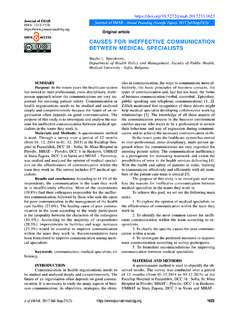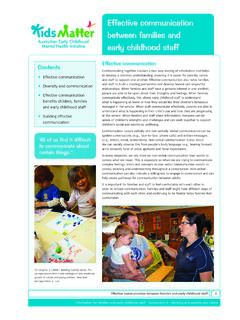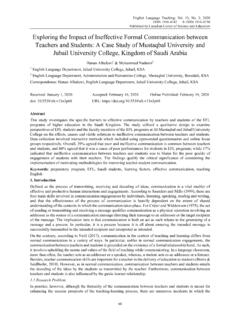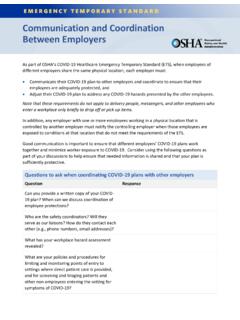Transcription of Improving communication between health care …
1 Improving communication between health care professionals and patients in the NHS in England Findings of a systematic evidence review and recommendations for an action plan Improving communication between health care professionals and patients in the NHS in England Findings of a systematic evidence review and recommendations for an action plan Contents Foreword .. i Executive summary .. ii 1. Introduction .. 1 2. Methods .. 3 3. Evidence regarding effective communication between clinicians and patients .. 9 4. Conclusions and recommendations .. 33 5. Acknowledgements .. 36 Literature search protocol .. A-1 Bibliography .. B-1 Data, calculations and assumptions underpinning the proposed intervention.
2 C-1 Project initiation document .. D-1 Contact: Peter Farrar Tel: 020 7391 4141 email: Approved by: Lauren Roberts Date: 29 June 2020 Director Improving communication between health care professionals and patients in the NHS in England Findings of a systematic evidence review and recommendations for an action plan i Foreword Andrew McDonald, Convener of the Chapter Two Group In 2016, when I wrote The Long and Winding Road, the reception to its publication was muted. The case it put forward was simple: improvements in communication between healthcare professionals and patients were likely to improve the quality of patient care and to reduce its cost. The patient and the taxpayer would benefit.
3 The first part of the case was not difficult to make. Indeed, it had been made many times before. But the second part was more innovative and apparently less easily received. It was almost as though there was some embarrassment about accepting a spend-to-save case in this aspect of public policy. The most that critics could say was that there was debate to be had about which element of healthcare should be the focus for the preferred investment. Nobody took issue with the core argument, just with its emphasis. A year passed and it seemed the report had lost its traction. To revive interest in the topic, I pressed the case with Sir Simon Stevens, CEO of NHS England, urging him to provide a substantive response to the report.
4 Here, after all, was an opportunity to improve healthcare and to save money, all at a time when the NHS was under exceptional budgetary pressure. But I was conscious that Sir Simon receives countless proposals for new expenditure plans. In that context, I congratulate him on his response. He commissioned a detailed study into how this invest-to-save project could be taken forward. Two years on we have in this report the results of the study commissioned by Sir Simon. The report has weighed the evidence and has been subject to rigorous review at each stage of its development. Its main recommendation is investment in a single, strategic intervention: training clinicians to have conversations with patients nearing the end of their lives about what these patients want from their care.
5 The patient benefits by themselves make a powerful case for introducing these conversations as routine practice across NHS Acute Hospital Trusts. The associated health system benefits quantified in the report make that case compelling. There will be discussion about the precise level of financial savings to be realised. But the return on investment estimated in this report is on such a scale, there cannot be any serious doubt that a positive return will be secured. We all know that studies by themselves do not make a jot of difference to patients experience of healthcare, nor do they save a pound of public expenditure. So I commend the recommendations of this systematic study to Sir Simon and his colleagues for immediate implementation.
6 The time for debate on the focus of investment is over, the time for action is now. Patients taxpayers will benefit. Improving communication between health care professionals and patients in the NHS in England Findings of a systematic evidence review and recommendations for an action plan ii Executive summary Introduction 1. Over the past 20 years a wealth of studies has shown the positive effects of interventions to improve communication between clinicians and patients. Studies from around the world demonstrate that effective patient/clinician communication can improve patients experiences and health outcomes. 2. Building on this evidence base and the 2016 report A Long and Winding Road, NHS England1 convened a Clinical Communications Steering Group (the Steering Group2) in 2018 to find out: Whether this evidence now supports systematic investment in Improving clinician/patient communication across NHS Acute Trusts in England If so, what particular intervention or interventions to target.
7 3. To answer these questions, the Steering Group commissioned a systematic review of the international literature on interventions to improve clinician-patient communication . Its aim was to identify interventions that have previously demonstrated a positive difference to patient experience and clinical outcomes, while also reducing financial demands on the health system. The options identified needed to be interventions that policy makers, commissioners and service managers across the NHS could replicate accurately, with a reasonable return on their investment and at a manageable level of implementation risk. 4. The systematic review has been undertaken by SQW, an independent research and consultancy organisation.
8 This report has been prepared by SQW and presents key findings from the systematic review and the evidence base which supports the case for investing in Improving communication between clinicians and patients in the NHS. 5. Of the options identified by the literature review, this report recommends that NHS England & NHS Improvement initially invest in a single intervention: introducing patient-centred goals of care conversations with patients presenting in Acute Medical Units (AMUs) and Surgical Assessment Units (SAUs) who are at risk of dying in the next 12 months and/or are at risk of serious clinical deterioration and death during their presentation. 6. These voluntary conversations between patients and a clinical member of staff take place within 48 hours of the patient s admission.
9 In the course of the conversation: the clinician gives the patient information about their condition and treatment options; the patient has the opportunity to express their particular values, goals, priorities and treatment preferences; the clinician hears and respects these values, priorities and preferences; and the clinician records them in a single care planning document. This document would be created during the first conversation and updated as needed during subsequent conversations. Patients and their 1 Since merged with NHS Improvement to form NHS England & NHS Improvement. 2 See Acknowledgements for members.
10 Improving communication between health care professionals and patients in the NHS in England Findings of a systematic evidence review and recommendations for an action plan iii families keep a paper copy of the original plan and any updates. Staff also record the decisions and any other key outcomes of the conversations in their organisation s electronic system. 7. The evidence indicates that introducing these conversations as routine clinical practice will significantly improve the experience of patients nearing the end of their lives, enhancing their quality of life while reducing their requirements for critical care. This reduction in demand for hospital care means the costs of introducing goals of care conversations are more than outweighed by the likely savings.


















